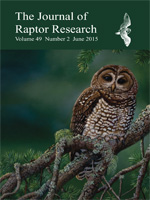Urban ecosystems are attractive to several raptor species, including the Mississippi Kite (Ictinia mississippiensis). To better understand the niche filled by urban-nesting Mississippi Kites, we observed nesting kites at 10 nests for a total of 269 hr during the breeding seasons of 2010 and 2011. We assessed prey delivery rates and prey use within and between years, evaluated the influences of nestling age, time of day, day of year, and local atmospheric conditions on delivery rates, and examined provisioning rates by male and female kites. A 62% decrease in the prey delivery rate, measured by the number of prey deliveries, from 2010 to 2011 was likely attributable to extreme heat and drought during the 2011 breeding season. However, total biomass of identified deliveries increased 38.9% in 2011 due to an increase in the percentage of avian prey (from 1% to 16% of identified deliveries). We suspect that differences in weather conditions between years influenced the type of prey delivered, and our modeling efforts indicated that year, nestling age, time of day, and temperature best explained the number of prey deliveries made per hour. On average, females delivered more prey items than males, but variability among nests suggested additional factors may influence parental effort. Our results suggest that Mississippi Kites exhibit prey switching under differing conditions.
How to translate text using browser tools
1 June 2015
Prey Use and Provisioning Rates of Urban-nesting Mississippi Kites in West Texas
Brandi C. Welch

Journal of Raptor Research
Vol. 49 • No. 2
June 2015
Vol. 49 • No. 2
June 2015
diet
Ictinia mississippiensis
Mississippi kite
nesting
Parental care
prey
provisioning rates




